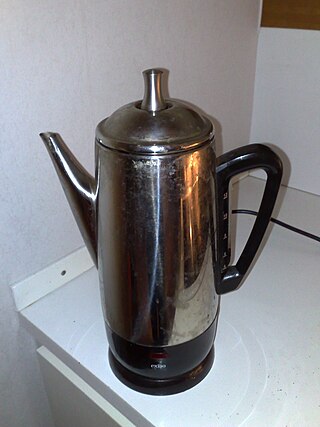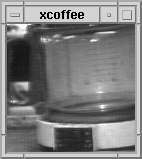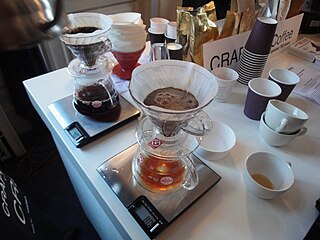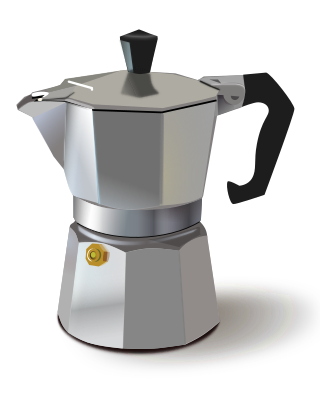Coffee pot is a cooking pot for making coffee. It may also refer to:

A teapot is a vessel used for steeping tea leaves or a herbal mix in boiling or near-boiling water, and for serving the resulting infusion which is called tea. It is one of the core components of teaware. Dry tea is available either in tea bags or as loose tea, in which case a tea infuser or tea strainer may be of some assistance, either to hold the leaves as they steep or to catch the leaves inside the teapot when the tea is poured. Teapots usually have an opening with a lid at their top, where the dry tea and hot water are added, a handle for holding by hand and a spout through which the tea is served. Some teapots have a strainer built-in on the inner edge of the spout. A small air hole in the lid is often created to stop the spout from dripping and splashing when tea is poured. In modern times, a thermally insulating cover called a tea cosy may be used to enhance the steeping process or to prevent the contents of the teapot from cooling too rapidly.

A French press, also known as a cafetière, cafetière à piston, caffettiera a stantuffo, press pot, coffee press, or coffee plunger, is a coffee brewing device, although it can also be used for other tasks. In 1923 Ugo Paolini, an Italian, filed patent documents relating to a tomato juice separator and he developed the idea of making a coffee pot with a press action and a filter. He assigned his 1928 patent to Italian designer Attilio Calimani and Giulio Moneta who filed it in 1929.

Brewed coffee is made by pouring hot water onto ground coffee beans, then allowing to brew. There are several methods for doing this, including using a filter, a percolator, and a French press. Terms used for the resulting coffee often reflect the method used, such as drip brewed coffee, filtered coffee, pour-over coffee, immersion brewed coffee, or simply coffee. Water seeps through the ground coffee, absorbing its constituent chemical compounds, and then passes through a filter. The used coffee grounds are retained in the filter, while the brewed coffee is collected in a vessel such as a carafe or pot.

A coffee percolator is a type of pot used for the brewing of coffee by continually cycling the boiling or nearly boiling brew through the grounds using gravity until the required strength is reached.

The Trojan Room coffee pot was a coffee machine located in the Computer Laboratory of the University of Cambridge, England. Created in 1991 by Quentin Stafford-Fraser and Paul Jardetzky, it was migrated from their laboratory network to the web in 1993 becoming the world's first webcam.

Turkish coffee is a style of coffee prepared in a cezve using very finely ground coffee beans without filtering.

A cezve is a small long-handled pot with a pouring lip designed specifically to make Turkish coffee. It is traditionally made of brass or copper, occasionally also silver or gold. In more recent times cezveler are also made from stainless steel, aluminium, or ceramics.

Arabic coffee is a version of the brewed coffee of Coffea arabica beans. Most Arab countries throughout the Middle East have developed distinct methods for brewing and preparing coffee. Cardamom is an often-added spice, but it can alternatively be served plain or with sugar.

Coffee preparation is the process of turning coffee beans into a beverage. While the particular steps vary with the type of coffee and with the raw materials, the process includes four basic steps: raw coffee beans must be roasted, the roasted coffee beans must then be ground, and the ground coffee must then be mixed with hot or cold water for a specific time (brewed), the liquid coffee extraction must be separated from the used grounds, and finally, if desired, the extracted coffee is combined with other elements of the desired beverage, such as sweeteners, dairy products, dairy alternatives, or toppings.

The moka pot is a stove-top or electric coffee maker that brews coffee by passing boiling water pressurized by steam through ground coffee. Named after the Yemeni city of Mocha, it was invented by Italian engineer Alfonso Bialetti in 1933 and quickly became one of the staples of Italian culture. Bialetti Industries continues to produce the same model under the trade name "Moka Express".

The George Sweeney Trial in 1806 in Richmond, Virginia was a trial in which George Sweeney, the grand-nephew of George Wythe, one of the Founding Fathers of the United States, was acquitted of murdering Wythe. Wythe was a distinguished attorney who attended the Philadelphia Convention in 1775 and signed the Declaration of Independence in 1776; in 1806, he died of arsenic poisoning. Before he died, Wythe accused his nephew of murder and changed his will to exclude him. Wythe's Black housekeeper provided evidence that George Sweeney had tried to poison Wythe, her son and her, but by law was prohibited from testifying in a criminal case against a white man. Sweeney was tried and found not guilty. The case is used as an example of how racism in early American law resulted in an acquittal.
The Coffee Pot, also known simply as Coffee Pot, with a shape suggesting a coffee pot, is an unpopulated steep, rocky islet located close to the south-western coast of Tasmania, Australia. It is situated some 2 kilometres (1.2 mi) northwest of where the mouth of Port Davey meets the Southern Ocean, the 0.31-hectare (0.77-acre) islet is part of the Trumpeter Islets Group, and comprises part of the Southwest National Park and the Tasmanian Wilderness World Heritage Site.

A coffeemaker, coffee maker or coffee machine is a cooking appliance used to brew coffee. While there are many different types of coffeemakers, the two most common brewing principles use gravity or pressure to move hot water through coffee grounds. In the most common devices, coffee grounds are placed into a paper or metal filter inside a funnel, which is set over a glass or ceramic coffee pot, a cooking pot in the kettle family. Cold water is poured into a separate chamber, which is then boiled and directed into the funnel and allowed to drip through the grounds under gravity. This is also called automatic drip-brew. Coffee makers that use pressure to force water through the coffee grounds are called espresso makers, and they produce espresso coffee.
Jacques Carelman was a French painter, illustrator and designer.

Klaas Gubbels is a Dutch painter and sculptor with a special love of coffeepots.

The Cape Government Railways 0-4-0ST 1881 Coffee Pot was a South African steam locomotive from the pre-Union era in the Cape of Good Hope.
Coffeepot Pass, elevation 12,726 ft (3,879 m), is a mountain gap and footpath located in the Maroon Bells–Snowmass Wilderness of Colorado. The pass offers a traverse over the Elk Mountains and connects the two counties of Gunnison and Pitkin.

The Metropolitan Museum of Art holds in its collection a number of items attributed to famed 18th-century French metalworker François Thomas Germain. Among these items is a silver coffee pot dated to 1757. The pot, a surviving example of French rococo dining ware, is currently on view at The Met Fifth Avenue in Gallery 545.

Dominick & Haff was an American silver manufacturer based in New York City. It was co-founded by Henry Blanchard Dominick and Leroy B. Haff in 1872, incorporated in 1889, and it closed down in 1928. The firm designed pots, mugs, centerpieces, spoons, tea sets and kettles. Examples can be seen at the Metropolitan Museum of Art, the Brooklyn Museum, Cooper Hewitt, the Indianapolis Museum of Art, the Art Institute of Chicago, the Museum of Fine Arts, Houston, and the Rhode Island School of Design Museum.